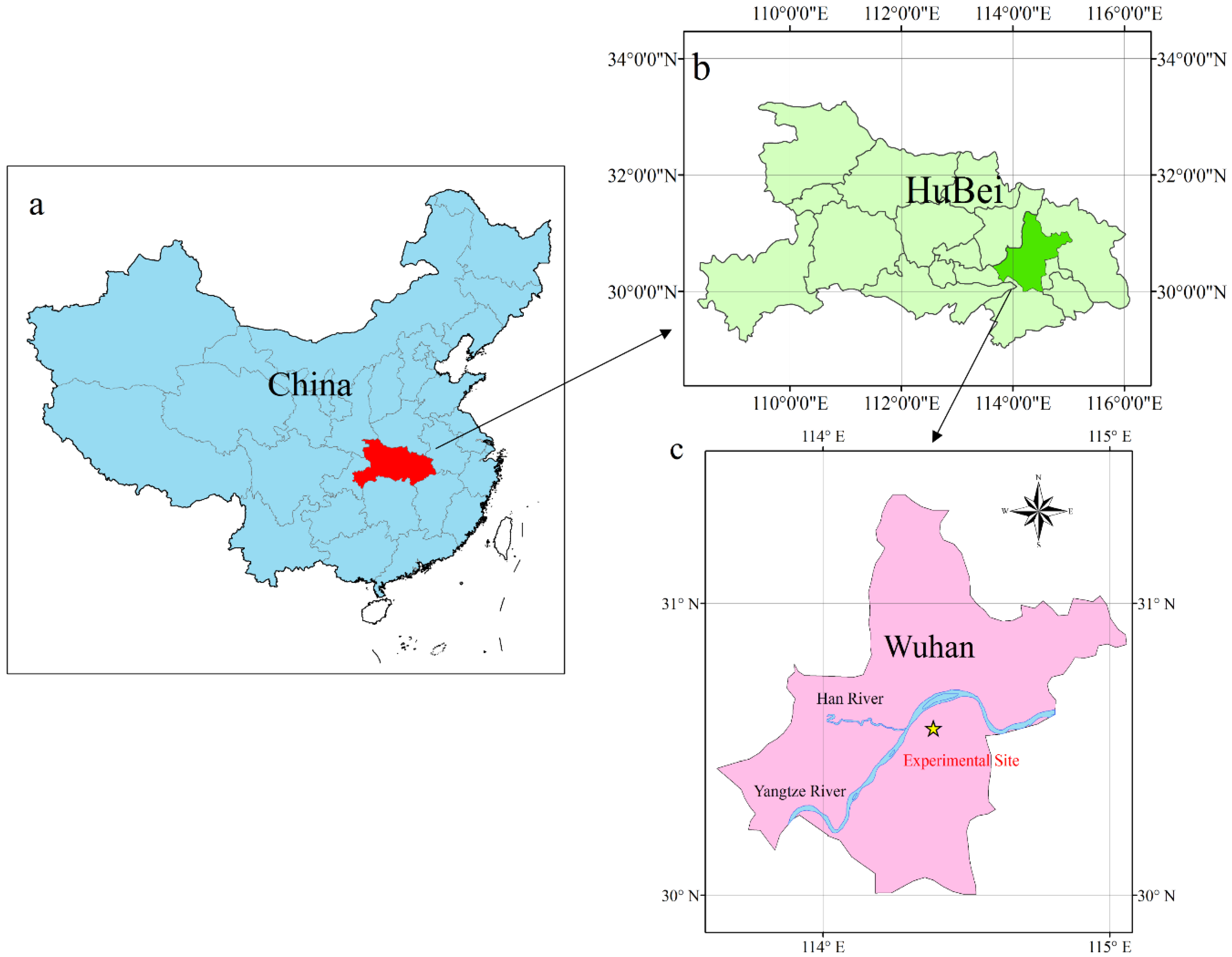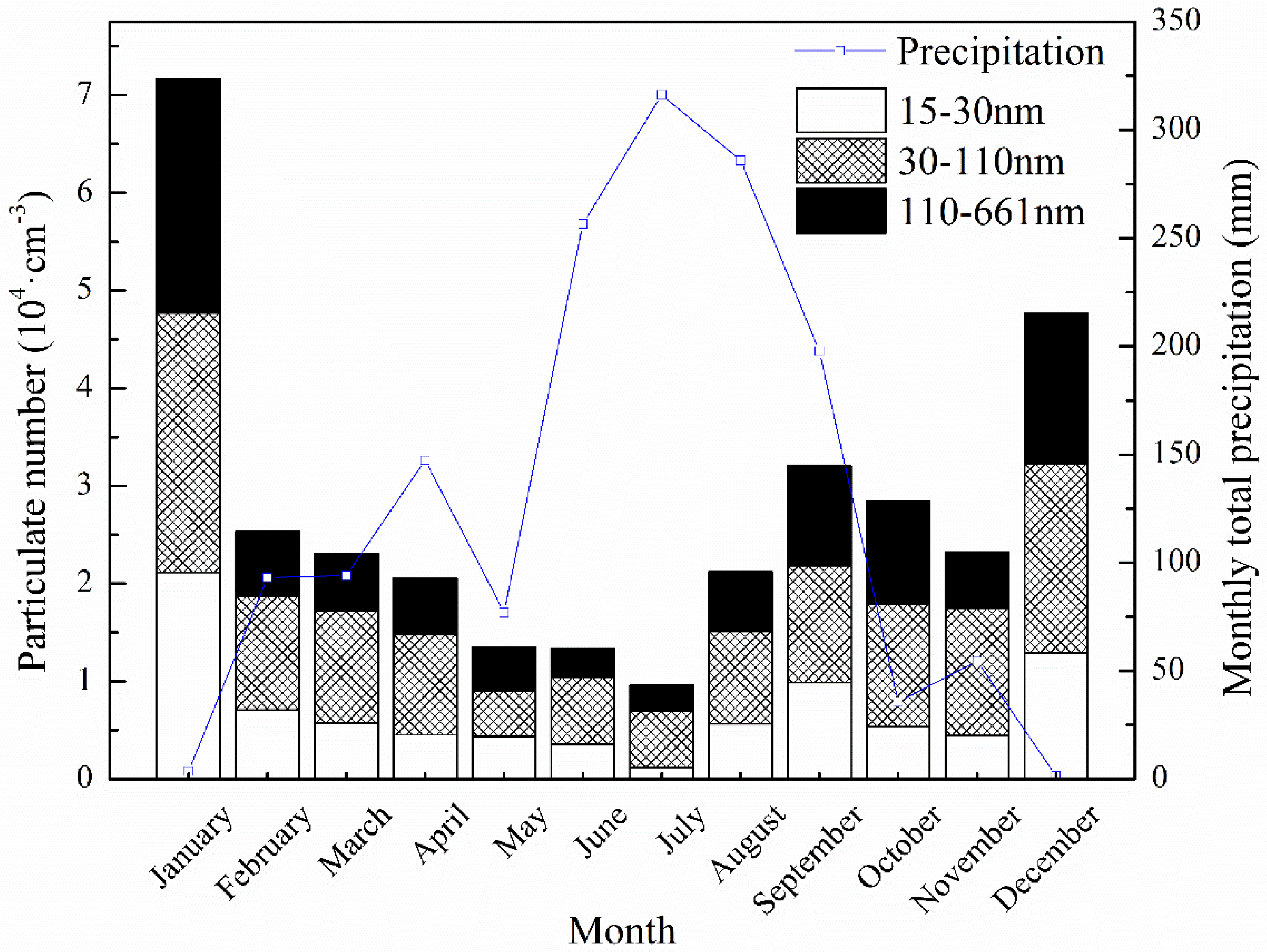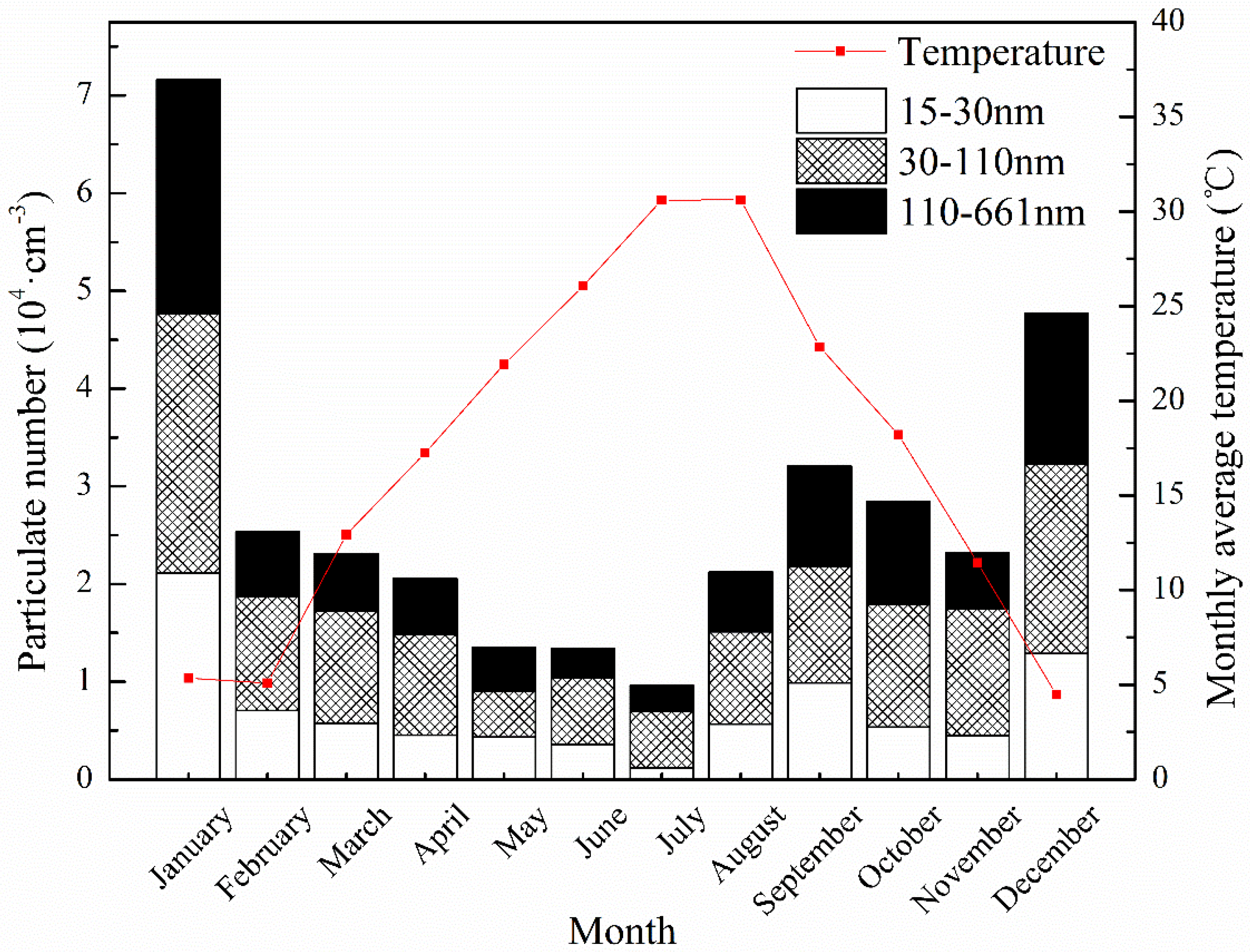Characteristics of Ultrafine Particles and Their Relationships with Meteorological Factors and Trace Gases in Wuhan, Central China
Abstract
:1. Introduction
2. Materials and Methods
2.1. Site Description
2.2. Measurements and Instrumentation
3. Results and Discussion
3.1. Seasonal Variability
3.2. Monthly Variability
3.3. Diurnal Variability
4. Conclusions
Acknowledgments
Author Contributions
Conflicts of Interest
References
- Charlson, R.J.; Schwartz, S.; Hales, J.; Cess, R.D.; Coakley, J.A., Jr.; Hansen, J.; Hofmann, D. Climate forcing by anthropogenic aerosols. Science 1992, 255, 423–430. [Google Scholar] [CrossRef] [PubMed]
- Ackerman, A.S.; Toon, O.; Stevens, D.; Heymsfield, A.; Ramanathan, V.; Welton, E. Reduction of tropical cloudiness by soot. Science 2000, 288, 1042–1047. [Google Scholar] [CrossRef] [PubMed]
- Koren, I.; Kaufman, Y.J.; Remer, L.A.; Martins, J.V. Measurement of the effect of amazon smoke on inhibition of cloud formation. Science 2004, 303, 1342–1345. [Google Scholar] [CrossRef] [PubMed]
- Stott, P.A.; Tett, S.; Jones, G.; Allen, M.; Mitchell, J.; Jenkins, G. External control of 20th century temperature by natural and anthropogenic forcings. Science 2000, 290, 2133–2137. [Google Scholar] [CrossRef] [PubMed]
- Ramanathan, V.; Crutzen, P.; Kiehl, J.; Rosenfeld, D. Aerosols, climate, and the hydrological cycle. Science 2001, 294, 2119–2124. [Google Scholar] [CrossRef] [PubMed]
- Rosenfeld, D.; Lohmann, U.; Raga, G.B.; O’Dowd, C.D.; Kulmala, M.; Fuzzi, S.; Reissell, A.; Andreae, M.O. Flood or drought: How do aerosols affect precipitation? Science 2008, 321, 1309–1313. [Google Scholar] [CrossRef] [PubMed]
- Coakley, J.A., Jr.; Cess, R.D.; Yurevich, F.B. The effect of tropospheric aerosols on the earth’s radiation budget: A parameterization for climate models. J. Atmos. Sci. 1983, 40, 116–138. [Google Scholar] [CrossRef]
- Gong, W.; Zhang, T.; Zhu, Z.; Ma, Y.; Ma, X.; Wang, W. Characteristics of PM1.0, PM2.5, and PM10, and their relation to black carbon in Wuhan, central China. Atmosphere 2015, 6, 1377–1387. [Google Scholar] [CrossRef]
- World Health Organization. Health Aspects of Air Pollution: Results from the WHO Project “Systematic Review of Health Aspects of Air Pollution in Europe”; WHO Regional Office for Europe: Copenhagen, Denmark, 2004. [Google Scholar]
- Karottki, D.G.; Spilak, M.; Frederiksen, M.; Jovanovic Andersen, Z.; Madsen, A.M.; Ketzel, M.; Massling, A.; Gunnarsen, L.; Møller, P.; Loft, S. Indoor and outdoor exposure to ultrafine, fine and microbiologically derived particulate matter related to cardiovascular and respiratory effects in a panel of elderly urban citizens. Int. J. Environ. Res. Public Health 2015, 12, 1667–1686. [Google Scholar] [CrossRef] [PubMed]
- Stanier, C.O.; Khlystov, A.Y.; Pandis, S.N. Ambient aerosol size distributions and number concentrations measured during the Pittsburgh Air Quality Study (PAQS). Atmos. Environ. 2004, 38, 3275–3284. [Google Scholar] [CrossRef]
- Kim, D.; Lim, K.; Xiang, R.; Lee, K. Design and performance evaluation of an aerosol separator. J. Aerosol Sci. 2002, 33, 1405–1415. [Google Scholar] [CrossRef]
- Jeong, C.-H.; Hopke, P.K.; Chalupa, D.; Utell, M. Characteristics of nucleation and growth events of ultrafine particles measured in Rochester, NY. Environ. Sci. Technol. 2004, 38, 1933–1940. [Google Scholar] [CrossRef] [PubMed]
- Gómez-Moreno, F.; Pujadas, M.; Plaza, J.; Rodríguez-Maroto, J.; Martínez-Lozano, P.; Artíñano, B. Influence of seasonal factors on the atmospheric particle number concentration and size distribution in Madrid. Atmos. Environ. 2011, 45, 3169–3180. [Google Scholar] [CrossRef]
- Wang, F.; Costabileb, F.; Li, H.; Fang, D.; Allegrini, I. Measurements of ultrafine particle size distribution near Rome. Atmos. Res. 2010, 98, 69–77. [Google Scholar] [CrossRef]
- Puustinen, A.; Hämeri, K.; Pekkanen, J.; Kulmala, M.; De Hartog, J.; Meliefste, K.; Ten Brink, H.; Kos, G.; Katsouyanni, K.; Karakatsani, A. Spatial variation of particle number and mass over four European cities. Atmos. Environ. 2007, 41, 6622–6636. [Google Scholar] [CrossRef]
- Li, X.; Wang, J.; Tu, X.; Liu, W.; Huang, Z. Vertical variations of particle number concentration and size distribution in a street canyon in Shanghai, China. Sci. Total Environ. 2007, 378, 306–316. [Google Scholar] [CrossRef] [PubMed]
- Wu, Z.; Hu, M.; Lin, P.; Liu, S.; Wehner, B.; Wiedensohler, A. Particle number size distribution in the urban atmosphere of Beijing, China. Atmos. Environ. 2008, 42, 7967–7980. [Google Scholar] [CrossRef]
- Zhao, S.; Yu, Y.; Yin, D.; He, J. Meteorological dependence of particle number concentrations in an urban area of complex terrain, Northwestern China. Atmos. Res. 2015, 164, 304–317. [Google Scholar] [CrossRef]
- Zhu, Y.; Hinds, W.C.; Kim, S.; Sioutas, C. Concentration and size distribution of ultrafine particles near a major highway. J. Air Waste Manag. Assoc. 2002, 52, 1032–1042. [Google Scholar] [CrossRef] [PubMed]
- Charron, A.; Harrison, R.M. Primary particle formation from vehicle emissions during exhaust dilution in the roadside atmosphere. Atmos. Environ. 2003, 37, 4109–4119. [Google Scholar] [CrossRef]
- Wehner, B.; Birmili, W.; Gnauk, T.; Wiedensohler, A. Particle number size distributions in a street canyon and their transformation into the urban-air background: Measurements and a simple model study. Atmos. Environ. 2002, 36, 2215–2223. [Google Scholar] [CrossRef]
- Morawska, L.; Jayaratne, E.; Mengersen, K.; Jamriska, M.; Thomas, S. Differences in airborne particle and gaseous concentrations in urban air between weekdays and weekends. Atmos. Environ. 2002, 36, 4375–4383. [Google Scholar] [CrossRef] [Green Version]
- Liu, S.; Hu, M.; Wu, Z.; Wehner, B.; Wiedensohler, A.; Cheng, Y. Aerosol number size distribution and new particle formation at a rural/coastal site in Pearl River Delta (PRD) of China. Atmos. Environ. 2008, 42, 6275–6283. [Google Scholar] [CrossRef]
- History Weather Records in Wuhan, National Meteorological Information Center of China. Available online: http://www.tianqihoubao.com/lishi/wuhan.html (accessed on 22 July 2016).
- Fischer, B.; Joffre, S.; Kukkonen, J.; Pringe, M.; Rotach, M.; Schatzmann, M. Meteorology Applied to Urban Air Pollution Problems, Final Report Cost Action 715; OPEC: Luxembourg, 1999. [Google Scholar]
- Finlayson-Pitts, B.J.; Pitts, J.N., Jr. Chemistry of the Upper and Lower Atmosphere: Theory, Experiments, and Applications; Academic Press: San Diego, CA, USA, 1999. [Google Scholar]
- Hussein, T.; Karppinen, A.; Kukkonen, J.; Härkönen, J.; Aalto, P.P.; Hämeri, K.; Kerminen, V.-M.; Kulmala, M. Meteorological dependence of size-fractionated number concentrations of urban aerosol particles. Atmos. Environ. 2006, 40, 1427–1440. [Google Scholar] [CrossRef]
- Chate, D.; Murugavel, P.; Ali, K.; Tiwari, S.; Beig, G. Below-cloud rain scavenging of atmospheric aerosols for aerosol deposition models. Atmo. Res. 2011, 99, 528–536. [Google Scholar] [CrossRef]
- Tiwari, S.; Bisht, D.; Srivastava, A.; Pipal, A.; Taneja, A.; Srivastava, M.; Attri, S. Variability in atmospheric particulates and meteorological effects on their mass concentrations over Delhi, India. Atmos. Res. 2014, 145, 45–56. [Google Scholar] [CrossRef]
- Gao, J.; Chai, F.; Wang, T.; Wang, W. Particle number size distribution and new particle formation (NPF) in Lanzhou, western China. Particuology 2011, 9, 611–618. [Google Scholar] [CrossRef]
- Jian, G.; Jin, W.; Cheng, S.-H.; Xue, L.-K.; Yan, H.-Z.; Hou, L.-J.; Jiang, Y.-Q.; Wang, W.-X. Number concentration and size distributions of submicron particles in Jinan urban area: Characteristics in summer and winter. J. Environ. Sci. 2007, 19, 1466–1473. [Google Scholar]
- Birmili, W.; Wiedensohler, A.; Heintzenberg, J.; Lehmann, K. Atmospheric particle number size distribution in central Europe-statistical relations to air masses and meteorology. J. Geophys. Res. D. Atmos. 2001, 106, 32. [Google Scholar] [CrossRef]
- Emanuel, K.A. Atmospheric Convection; Oxford University Press: New York, NY, USA, 1994. [Google Scholar]
- Fernando, H.J.; Chen, R.-R.; Boyer, D.L. Effects of rotation on convective turbulence. J. Fluid Mech. 1991, 228, 513–547. [Google Scholar] [CrossRef]
- Canuto, V.; Mazzitelli, I. Stellar turbulent convection—A new model and applications. Astrophys. J. 1991, 370, 295–311. [Google Scholar] [CrossRef]
- Castro, A.; Alonso-Blanco, E.; González-Colino, M.; Calvo, A.I.; Fernández-Raga, M.; Fraile, R. Aerosol size distribution in precipitation events in León, Spain. Atmos. Res. 2010, 96, 421–435. [Google Scholar] [CrossRef]








| Correlation Coefficient | 15–30 nm | 30–110 nm | 110–665 nm |
|---|---|---|---|
| Precipitation | −0.557 | −0.656 * | −0.618 * |
| Temperature | −0.622 * | −0.740 ** | −0.610 * |
| Mixing Layer Height | −0.594 * | −0.909 ** | −0.657 * |
| Wind Speed | −0.487 | −0.515 | −0.531 |
© 2016 by the authors; licensee MDPI, Basel, Switzerland. This article is an open access article distributed under the terms and conditions of the Creative Commons Attribution (CC-BY) license (http://creativecommons.org/licenses/by/4.0/).
Share and Cite
Zhang, T.; Zhu, Z.; Gong, W.; Xiang, H.; Li, Y.; Cui, Z. Characteristics of Ultrafine Particles and Their Relationships with Meteorological Factors and Trace Gases in Wuhan, Central China. Atmosphere 2016, 7, 96. https://doi.org/10.3390/atmos7080096
Zhang T, Zhu Z, Gong W, Xiang H, Li Y, Cui Z. Characteristics of Ultrafine Particles and Their Relationships with Meteorological Factors and Trace Gases in Wuhan, Central China. Atmosphere. 2016; 7(8):96. https://doi.org/10.3390/atmos7080096
Chicago/Turabian StyleZhang, Tianhao, Zhongmin Zhu, Wei Gong, Hao Xiang, Ying Li, and Zhenzhen Cui. 2016. "Characteristics of Ultrafine Particles and Their Relationships with Meteorological Factors and Trace Gases in Wuhan, Central China" Atmosphere 7, no. 8: 96. https://doi.org/10.3390/atmos7080096







